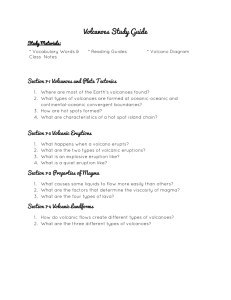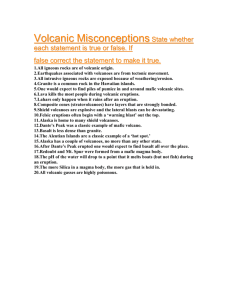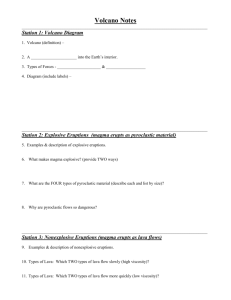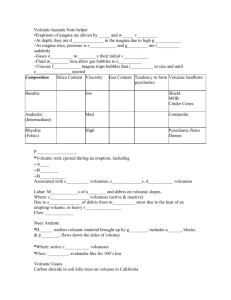Volcanoes
advertisement
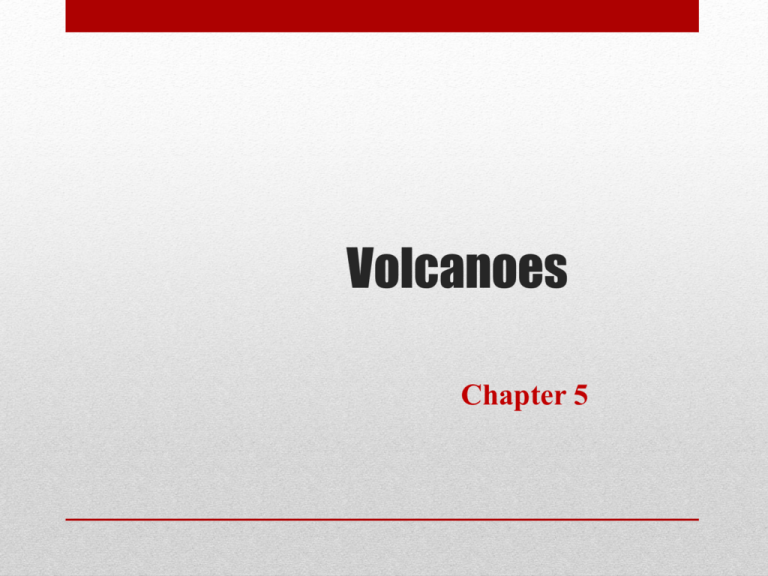
Volcanoes Chapter 5 Rigid Earth to Plate Tectonics • Learning Objectives Know the different types of volcanoes and their associated features Understand the relationship of the volcanoes to plate tectonics Know what geographic regions are at risk from volcanoes Know the effects of volcanoes and how they are linked to other natural hazards Recognize the potential benefits of volcanic eruptions Understand how we can minimize the volcanic hazard Know what the adjustments we can make to avoid death and damage from volcanoes Volcanic Eruption Introduction to Volcanoes • Volcanic Activity – Volcanism Directly related to plate tectonics, with most being located near plate boundaries Related to the spreading or sinking of lithospheric plates as these plate boundaries interact with each other Produces magma when found within the earth or lava when found on the Earth’s surface Constructed around a “vent” through which lava and other materials are extruded onto the surface Approximately 2/3 of all active volcanoes are located along the “Ring of Fire” that surrounds the Pacific Ocean Locations of Volcanoes around the World How Magma Forms • The plates do not actually move around on an ocean of molten rock The earth is really solid rock except for the outer core So where does the molten rock comes from? Most magma comes from the asthenosphere • Decompression melting – when overlying pressure is exerted on hot rock within the asthenosphere is decreased Happens at Hot Spots and Divergent boundaries • Addition of volatiles lowers the melting temperature of rocks by helping to break chemical bonds within silicate minerals Volatiles are chemical compounds, such as such as water or carbon dioxide that evaporate and exist in a gaseous state at the earth’s surface • Addition of heat to rocks will induce melting if the temperature of the rocks exceeds the melting temperature of silicate rocks at that depth Properties of Magma • Magma is made up of melted silicate rocks • They are Basaltic, Andesitic, and Rhyolitic rocks • These rocks each contain different percentages of silica. This difference changes the viscosity of the magma Basaltic magma – low in silica -- 50% Andesitic and Rhyolitic magma – high in silica – 60% to 70% Rocks low in silica are known as mafic Rocks high in silica are know as felsic Magma is less dense than surrounding rock therefore it rises buoyantly towards the surface As the magma moves to the surface, additional chemical processes and additional melting of surrounding rock add to the felsic property of the magma When the magma reaches the surface, its properties – viscosity and volatile content help to determine the kind of volcano it builds Properties of Magma • Viscosity is the resistance to flow due to greater amounts of silica in the magma Fluids that do not flow easily, such as molasses or cold honey are high in silica magma and have high viscosity Fluids that flow like water or warm honey are low in silica and have low viscosity The variability in magma viscosity is strongly influenced by The mobility of the magma in the subsurface The velocity and the form it takes when it reaches the surface • Volatile content and eruptive behavior of the volcano is connected to a high concentration of dissolved volatiles within the magma Properties of Magma Types of Volcanoes • Lave Dome Small, less than 2000 ft. high, irregular shape Solidified thick viscous lava Magma high in silica, often Common in islands, Hawaii and Iceland rhyolite • Shield Broad, gentle slope Largest volcano in the world Layers of lava flows Basaltic magma, quiet eruptions • Composite or Strato Large, steep, symmetrical Beautiful cone shape Layers of lava, proclastic Magma andesitic, both explosive and quiet eruptions Mt. Fuji, Mt. St. Helen, Mt. Rainier • Cinder Cone • Small Steep-sided. • Loose pyroclastic material • Magma varies from basaltic to pyroclastic Parts of Volcanoes • Volcanoes are more than complex systems than a mountain that spews lava These systems include: Craters, calderas, volcanic vents, geysers, and hot springs o Craters – formed at the tops of volcanoes during the explosion o Volcanic vent -- an opening through where lava and pyroclastic matter erupts o Hot Springs or geysers – where groundwater comes into contact with hot rock o Caldera --a crater produced from a collapsed volcano How a Caldera is Formed Volcanic Features • Volcanic intrusions – when the magma solidifies below the surface producing a igneous intrusion Dikes – a vertical or nearly vertical sheet of magma thrust upward into preexisting rock Sills– a long, thin intrusive body with its orientation determined by the structure of the preexisting rocks Veins – least prominent- thin veins of igneous rock that are pushed up through small fractures of preexisting rocks Batholiths -- a subterranean igneous body of indefinite depth and enormous in size. Often the core of mountain ranges Stocks – Similar to the batholiths but much smaller. Often an offshoot of batholiths Laccoliths– produces by slow-flowing viscous magma is forced between horizontal layers of preexisting rock Volcanic Origins Volcanic Origins Volcanic Origins • Mid-ocean ridges and continental rifts Produces basaltic magma Produces shield volcanoes Volcanoes found in Iceland are examples • Subduction Zones Found around the Pacific Rim Produces andesitic composite volcanoes Combination of basalt and silica magma, the higher the silica, the more pyroclastic Volcanoes found in Japan, Oregon, Washington, and Alaska are examples • Convergent Boundaries– where plates collide destructive boundaries Most massive and spectacular of earthly landforms Mountains & volcanoes Deep ocean trenches Volcanic Origins • Hot Spots – under the ocean Spots of volcanic activity caused by a thin Earth’s crust allowing the magma to move to the surface found in the ocean A Hot Spot built the Hawaiian Archipelago As the plate moves across the Hot Spot, a hot spot trail of volcanic islands are left, such as the Hawaiian Islands or Midway • Mantle Plumes – under continents Spots of volcanic activity caused by a thin Earth’s crust allowing the magma to move to the surface under continents Yellowstone sits over a mantle plume As the North American plate moves across this mantle plume, Yellowstone has moved across the country Mantle plumes helped to explain volcanic activity in the middle of continental plates and helped to distinguish the direction of the plate’s movement Geographic Regions at Risk from Volcanoes • Earthquakes and volcanoes are related to Tectonics found around the Ring of Fire Geographic Regions at Risk from Volcanoes • Hot spots or riffs found in the Pacific Ocean or at mid-ocean ridges Geographic Regions at Risk from Volcanoes • Areas along the Pacific Coast, in Yellowstone and in isolated areas of the Southwest are at risk Effects of Volcanoes • Worldwide, 50 to 60 volcanoes erupt every year Many of these eruptions do not affect many people However when an eruption does take place near a densely populated area the effects are catastrophic • Volcanic hazards include the primary effects of volcanic activity that are the direct results of an eruption • Secondary effects are the results of the primary effect Effects of Volcanoes • Primary Effects Lava flows – Basaltic, Andesitic & Rhyolitic Rarely cause loss of life, but cause lots of damage o Pahoehoe flows Basaltic lava-lower viscosity and higher eruptive temperatures, are the fastest flowing o Pyroclastic flows Explosive eruption causes high speed avalanche of searing hot gases, ash, and rock fragments Volcanic Ash Covers hundreds to thousands of miles of vegetation, contaminates surface water, damages buildings as ash piles on roofs, creates health hazards, and can cause flame outs in airplane engines Volcanic Gases Emissions of noxious gases such as carbon dioxide, sulfur dioxide, hydrogen sulfide, and fluorine Eruption Column and Clouds Changes the air quality and weather Effects of Volcanoes • Secondary Effects Volcanic Mudflows (Lahars) A loose mantle of ash and proclastic flow on the sides of a volcano slides during a heavy rain storm Debris flows Volcanic eruptions melt snows causing meltwater debris flows including fine sediment and large rocks Mudflows Gigantic mudflows can be caused by the eruption Landslides Can be triggered by events other than an eruption. Large volcanic landslides may affect areas far from their source Floods, Fires, and Tsunamis may also be secondary effects of a volcanic eruptions Linkages between Volcanoes and other Natural Hazards • Volcanoes are linked to their physical environment as well as to several other natural hazards There are the several kinds relationships Plate tectonic setting and the type of magma The influence that magma type has on the nature of volcanic eruptions Volcanic eruptions can also be directly related to o Fires o Earthquakes o Landslides o Change in global climates Yes, these are the same effects that cause the hazards from volcanoes Natural Service Function of Volcanoes • Volcanoes provide important natural service functions Volcanic Soils Provides excellent growth medium for vegetation Geothermal Power Used to create power for nearby urban areas Mineral Resources Host source for many mineral resources Recreation Creates health spas and hot springs Creation of New Land Responsible for the creation of new land during the eruption Human Interaction with Volcanoes • Unlike earthquakes, volcanoes do not lend themselves to human intervention, little can be done to stop them • We can not affect the timing and severity of their eruptions • Unlike the activities of man can enhance earthquakes or floods, there doesn’t seem to be any activity related to man that affects volcanic activities • Volcanoes are truly a hazard that is beyond our control. The best we can do is try to minimize loss of life and property associated with eruptions Minimizing the Volcanic Hazards • Forecasting – Eruptions cannot be forecast, but certain information can be obtained that can help in trying to predict an eruption Monitoring seismic activity Small earthquakes around the area of a volcano Monitoring thermal, magnetic, and hydrologic conditions Magma accumulation can heat rock or water, change magnetic stimulus or change water temperature Monitoring the land surface to detect tilting or swelling of the volcano The change in the land surface around a volcano can indicate change in the volcano Monitoring volcanic gas emissions A volcano getting ready to erupt can have a change in gas emissions Studying the geologic history of a particular volcano or volcanic center Understanding the geologic history of the volcano can help in knowing if it is going to erupt Volcanic Alert or Warning • When should the public be alerted to the emanate danger of a volcanic eruption Using a system of ground-based levels and aviationbased color code levels, the public can be alerted to a volcanic eruption Developed by USGS, used by 5 volcanic observatories Each component has four levels for monitoring Usually the alerts for the volcanoes and eruptions will be the same for both levels (ground and aviation) But for some, the ground alert maybe more than the aviation or reversed, depending the kind of volcano Perception of and Adjustment to the Volcanic Hazard • Information concerning how people perceive a volcanic hazard is limited • People live near volcanoes for a variety of reasons 1. They were born there and in the case of some islands, all land is volcanic 2. The land is fertile and good for farming 3. People are optimistic and believe an eruption is unlikely 4. They cannot choose where they live, they may be limited by economics • The best way to limit concern about living near a volcano would be to better understand the what needs to be done in a volcanic crisis Perception of and Adjustment to the Volcanic Hazard • Adjustments to Volcanic Hazards Major adjustment in understand why to evacuate People need to understand the hazards and when told to evacuate Some places are offering rewards to relocate • Attempts to control lava flows There have been some attempts to regulate the flow of lava One way is called hydraulic chilling and wall construction where the flow of lava is controlled o For this to work, three things have to be available Slow movement of lava Available transportation and roads to move the machinery on Water is readily available Iceland Effort to Control Lava Lava Flow

